+ Author Affiliations
- Author Affiliations
A CSIRO Sustainable Ecosystems, 306 Carmody Road, St Lucia, Qld 4067, Australia.
B Current address: Centre for Applied Conservation Research, Department of Forest Sciences, University of British Columbia, 3041-2424 Main Mall, Vancouver, BC V6T 1Z4, Canada.
C Queensland Department of Natural Resources, Mines and Water, Charter Towers, Qld 4820, Australia.
D Cooperative Research Centre for Australian Weed Management, PMB 1, Waite Campus, Glen Osmond, SA 5064, Australia.
E Corresponding author. Email: Tara.Martin@ubc.ca
Acknowledgments
Many people have contributed to the compilation of this review, for which we are most grateful. In particular, we would like to acknowledge Sandy Lloyd, Nathan March, John Pitt, John Thorpe and Associates and Jason Weber. Participants of the weeds, biodiversity and rangeland workshop held in Brisbane 2005 (Nora Brandli, Yvonne Buckley, Steve Csurhes, Dane Panetta, Joe Vitelli, Craig Walton, Richard Carter, Mike Cole, Mic Julien, Rieks van Klinken, Rachel McFadyen, John Morley and Anita Smyth) and staff of the Co-operative Research Centre for Australian Weed Management and the Department of Environment and Heritage generously provided assistance. This manuscript benefited from comments from two anonymous referees.
References
ARMCANZ (Agriculture and Resource Management Council of Australia and New Zealand, Australian and New Zealand Environment and Conservation Council) (1999). ‘The national weeds strategy: a strategic approach to weed problems of national significance.’ (Commonwealth of Australia: Canberra.)
Auld
B. A.
, and
Medd
R. W.
(1992). ‘Weeds: an illustrated botanical guide to the weeds of Australia.’ (Inkata Press: Melbourne.)
Australian Weeds Committee (2004). ‘Noxious weed list for Australian states and territories.’ Available online at: www.weeds.org.au/noxious.htm (accessed 20 March 2006).
Braithwaite R. W.,
Lonsdale W. M., Estbergs J. A.
(1989) Alien vegetation and native biota in tropical Australia: the impact of Mimosa pigra. Biological Conservation 48, 189–210.
| Crossref | GoogleScholarGoogle Scholar |
(accessed 20 March 2006).
Department of the Environment and Heritage (2006). ‘Weeds on the national environmental alert list.’ (Commonwealth of Australia: Canberra.) Available online at: www.deh.gov.au/biodiversity/invasive/weeds/alert-list.html (accessed 20 March 2006).
Department of Natural Resources and Mines (2001
a). ‘Cape York Peninsula weed pocket guide.’ (Web and Publishing Services, Department of Natural Resources and Mines: Brisbane.)
Department of Natural Resources and Mines (2001
b). ‘Weed pocket guide of agricultural and environmental weeds in far North Queensland.’ (Web and Publishing Services, Department of Natural Resources and Mines: Brisbane.)
Department of Natural Resources and Mines (2003). ‘Weed pocket guide for the Burdekin Dry Tropics.’ (Web and Publishing Services, Department of Natural Resources and Mines: Brisbane.)
Fairfax R. J., Fensham R. J.
(2000) The effect of exotic pasture development on floristic diversity in central Queensland, Australia. Biological Conservation 94, 11–21.
| Crossref | GoogleScholarGoogle Scholar |
(accessed 20 March 2006).
2 IK accessed via the International Plant Names Index www.ipni.org/copyright.html (accessed 20 March 2006).
3
www.weeds.crc.org.au/publications/weed_man_guides.html (accessed 20 March 2006).
4
www.deh.gov.au/biodiversity/invasive/publications/#weeds (accessed 24 March 2006).
5
www.deh.gov.au/biodiversity/invasive/publications/#weeds (accessed 24 March 2006).
6
www.weeds.org.au/weedident.htm (accessed 24 March 2006).
Appendix 1. List of 622 non-native plant species that occur in the rangelands, including 153 species, representing 94 taxa (Table 2), which pose a threat to rangeland biodiversity
Species known to have an impact on rangeland biodiversity are noted (Y). The list was compiled using published literature (Table 1) and expert knowledge (see Acknowledgments). Where possible, nomenclature follows the Australian Plant Name Index (APNI)A, otherwise Index KewensisB is used
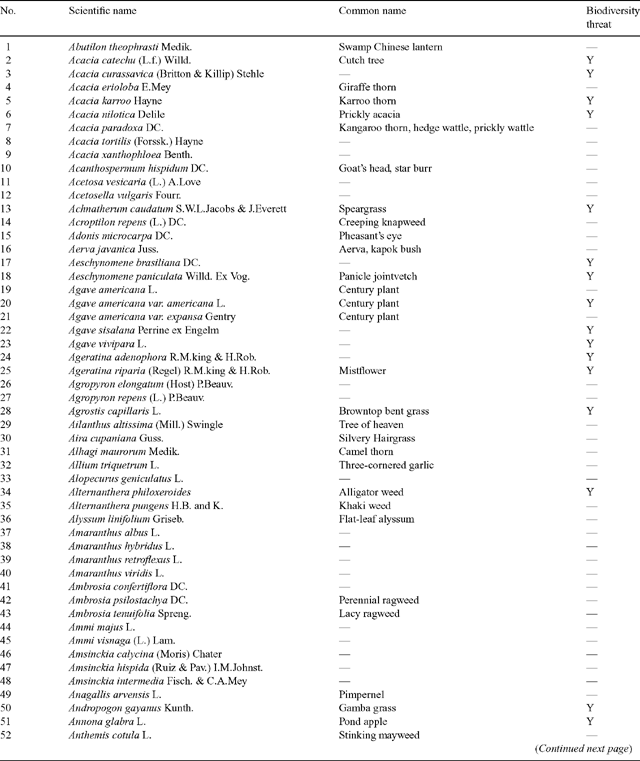
|
Appendix 1B. List of 622 non-native plant species that occur in the rangelands, including 153 species, representing 94 taxa (Table 2), which pose a threat to rangeland biodiversity
Species known to have an impact on rangeland biodiversity are noted (Y). The list was compiled using published literature (Table 1) and expert knowledge (see Acknowledgments). Where possible, nomenclature follows the Australian Plant Name Index (APNI)A, otherwise Index KewensisB is used
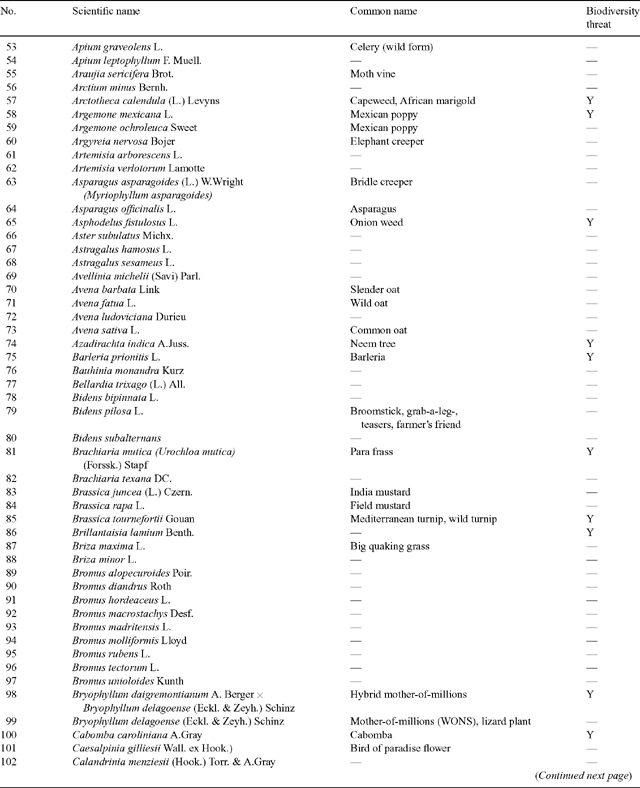
|
Appendix 1C. List of 622 non-native plant species that occur in the rangelands, including 153 species, representing 94 taxa (Table 2), which pose a threat to rangeland biodiversity
Species known to have an impact on rangeland biodiversity are noted (Y). The list was compiled using published literature (Table 1) and expert knowledge (see Acknowledgments). Where possible, nomenclature follows the Australian Plant Name Index (APNI)A, otherwise Index KewensisB is used
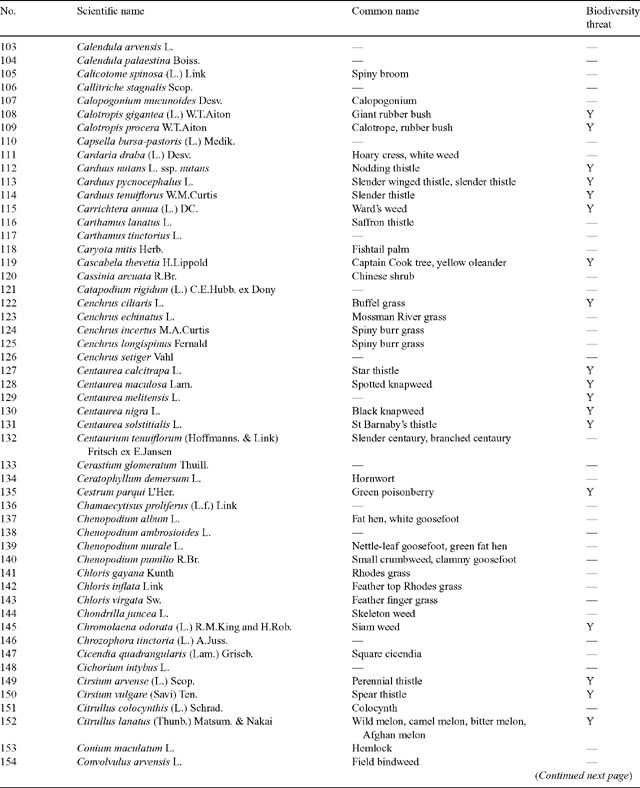
|
Appendix 1D. List of 622 non-native plant species that occur in the rangelands, including 153 species, representing 94 taxa (Table 2), which pose a threat to rangeland biodiversity
Species known to have an impact on rangeland biodiversity are noted (Y). The list was compiled using published literature (Table 1) and expert knowledge (see Acknowledgments). Where possible, nomenclature follows the Australian Plant Name Index (APNI)A, otherwise Index KewensisB is used
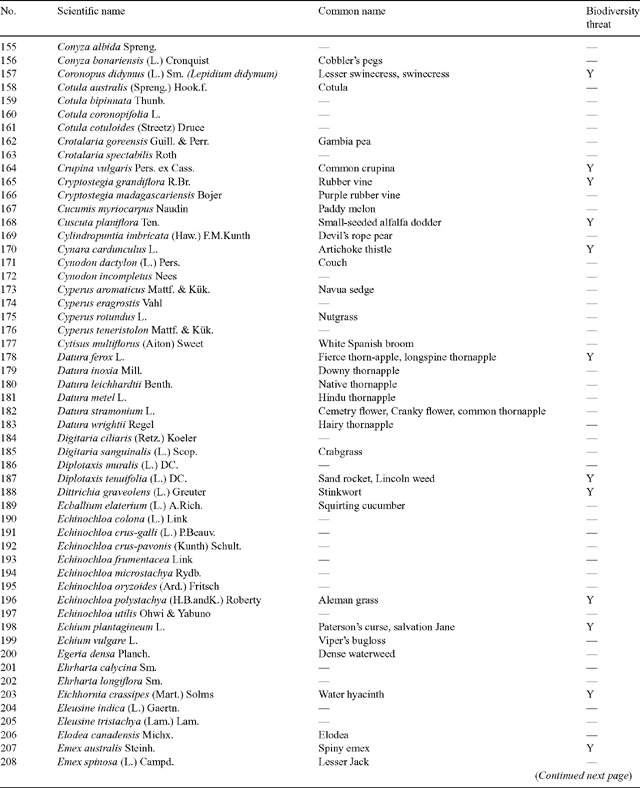
|
Appendix 1E. List of 622 non-native plant species that occur in the rangelands, including 153 species, representing 94 taxa (Table 2), which pose a threat to rangeland biodiversity
Species known to have an impact on rangeland biodiversity are noted (Y). The list was compiled using published literature (Table 1) and expert knowledge (see Acknowledgments). Where possible, nomenclature follows the Australian Plant Name Index (APNI)A, otherwise Index KewensisB is used
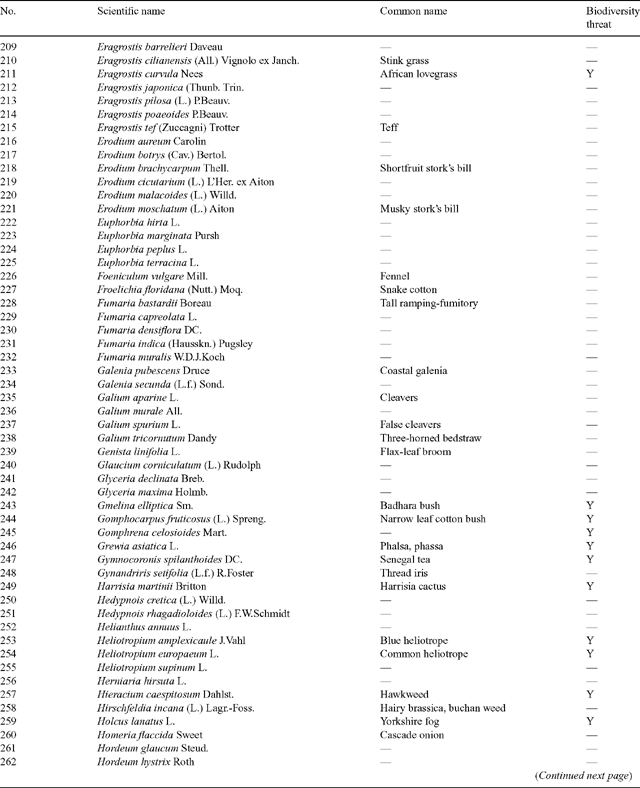
|
Appendix 1F. List of 622 non-native plant species that occur in the rangelands, including 153 species, representing 94 taxa (Table 2), which pose a threat to rangeland biodiversity
Species known to have an impact on rangeland biodiversity are noted (Y). The list was compiled using published literature (Table 1) and expert knowledge (see Acknowledgments). Where possible, nomenclature follows the Australian Plant Name Index (APNI)A, otherwise Index KewensisB is used
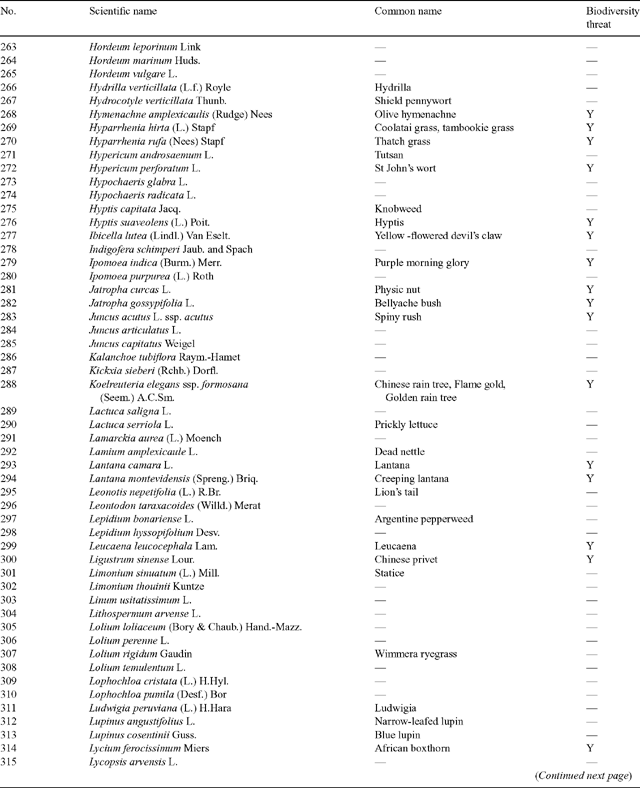
|
Appendix 1G. List of 622 non-native plant species that occur in the rangelands, including 153 species, representing 94 taxa (Table 2), which pose a threat to rangeland biodiversity
Species known to have an impact on rangeland biodiversity are noted (Y). The list was compiled using published literature (Table 1) and expert knowledge (see Acknowledgments). Where possible, nomenclature follows the Australian Plant Name Index (APNI)A, otherwise Index KewensisB is used
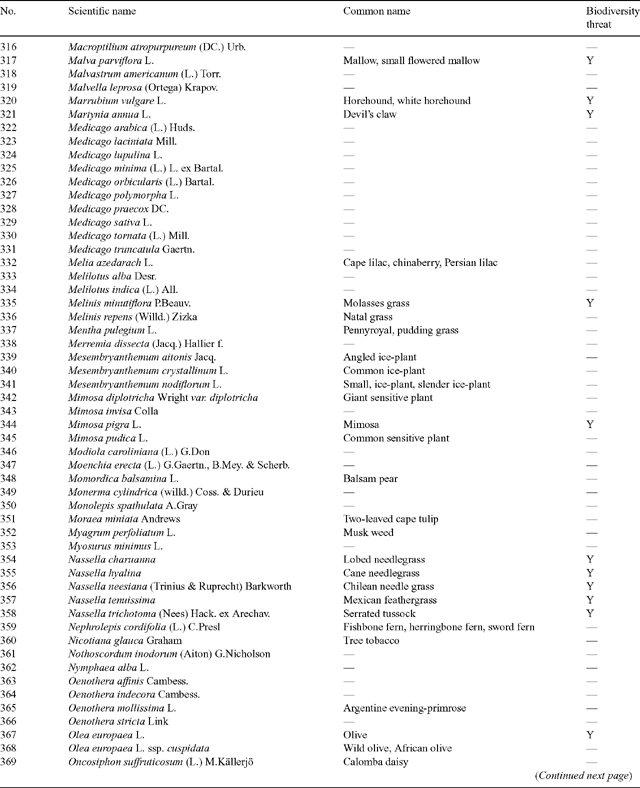
|
Appendix 1H. List of 622 non-native plant species that occur in the rangelands, including 153 species, representing 94 taxa (Table 2), which pose a threat to rangeland biodiversity
Species known to have an impact on rangeland biodiversity are noted (Y). The list was compiled using published literature (Table 1) and expert knowledge (see Acknowledgments). Where possible, nomenclature follows the Australian Plant Name Index (APNI)A, otherwise Index KewensisB is used
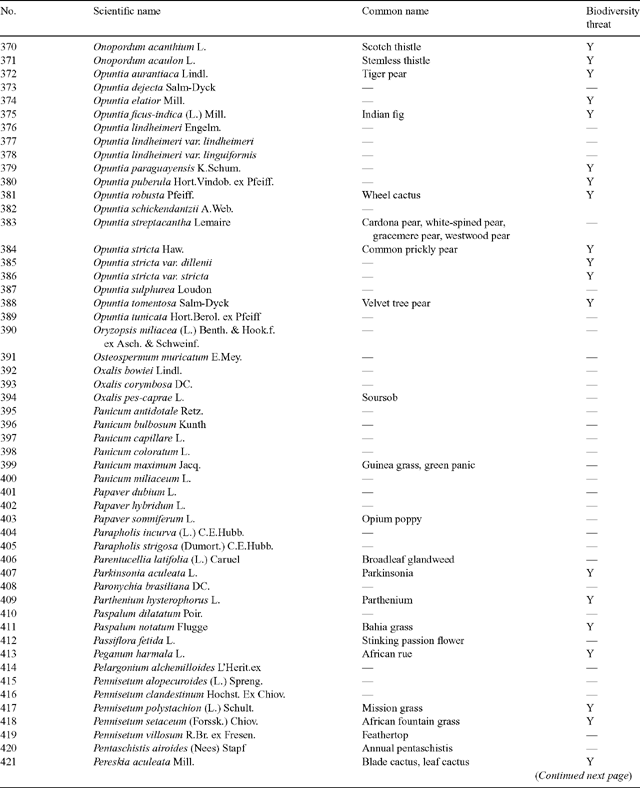
|
Appendix 1I. List of 622 non-native plant species that occur in the rangelands, including 153 species, representing 94 taxa (Table 2), which pose a threat to rangeland biodiversity
Species known to have an impact on rangeland biodiversity are noted (Y). The list was compiled using published literature (Table 1) and expert knowledge (see Acknowledgments). Where possible, nomenclature follows the Australian Plant Name Index (APNI)A, otherwise Index KewensisB is used
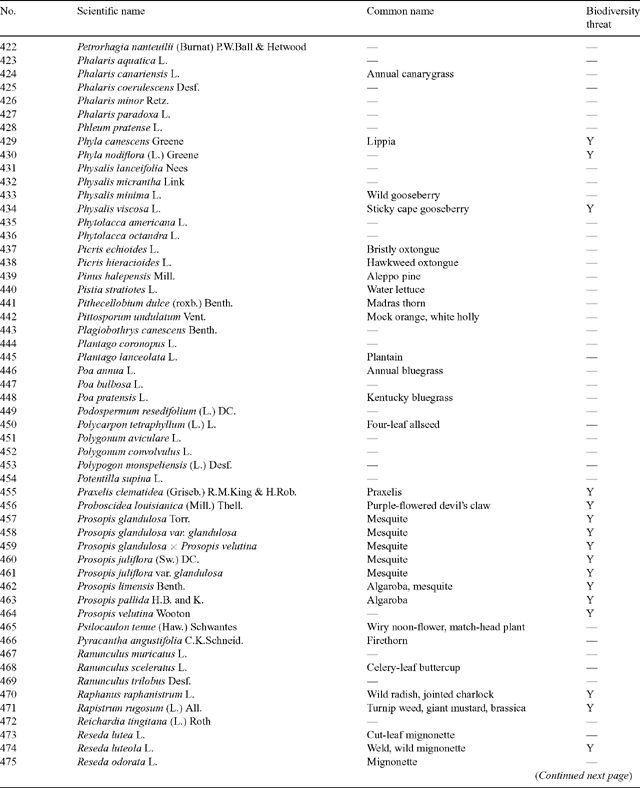
|
Appendix 1J. List of 622 non-native plant species that occur in the rangelands, including 153 species, representing 94 taxa (Table 2), which pose a threat to rangeland biodiversity
Species known to have an impact on rangeland biodiversity are noted (Y). The list was compiled using published literature (Table 1) and expert knowledge (see Acknowledgments). Where possible, nomenclature follows the Australian Plant Name Index (APNI)A, otherwise Index KewensisB is used
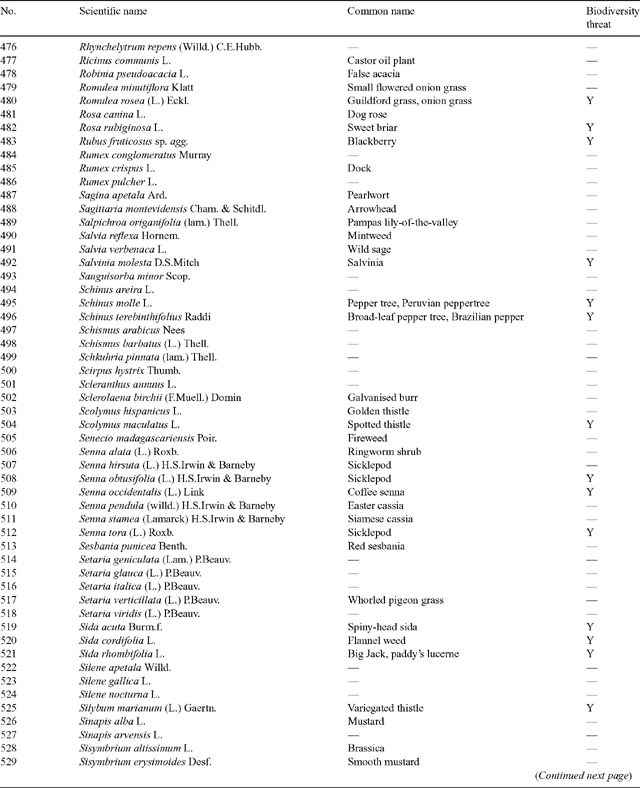
|
Appendix 1K. List of 622 non-native plant species that occur in the rangelands, including 153 species, representing 94 taxa (Table 2), which pose a threat to rangeland biodiversity
Species known to have an impact on rangeland biodiversity are noted (Y). The list was compiled using published literature (Table 1) and expert knowledge (see Acknowledgments). Where possible, nomenclature follows the Australian Plant Name Index (APNI)A, otherwise Index KewensisB is used
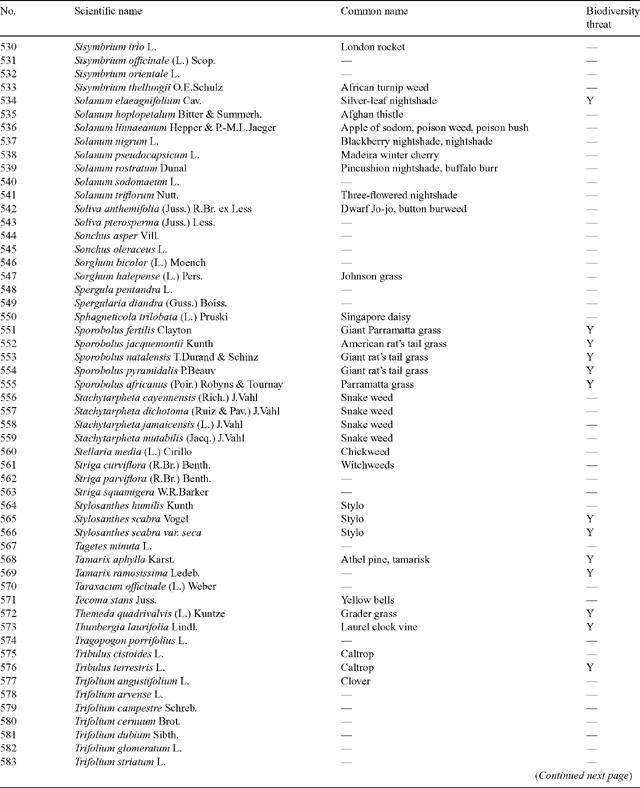
|
Appendix 1L. List of 622 non-native plant species that occur in the rangelands, including 153 species, representing 94 taxa (Table 2), which pose a threat to rangeland biodiversity
Species known to have an impact on rangeland biodiversity are noted (Y). The list was compiled using published literature (Table 1) and expert knowledge (see Acknowledgments). Where possible, nomenclature follows the Australian Plant Name Index (APNI)A, otherwise Index KewensisB is used
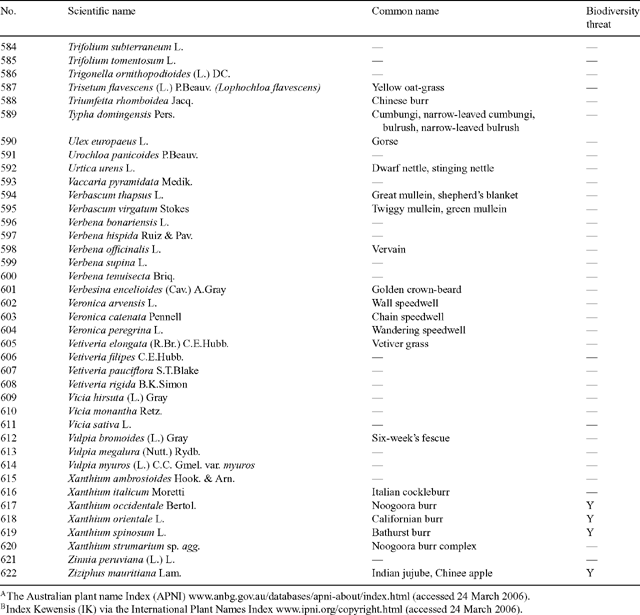
|
Appendix 2. Interim Biogeographic Regionalisation of Australia (IBRA) regions that occur in the rangelands
Of the 85 IBRA regions, 53 contain rangelands and are listed below along with the state/territory in which they occur. Victoria and Tasmania do not contain rangelands and hence are not listed below
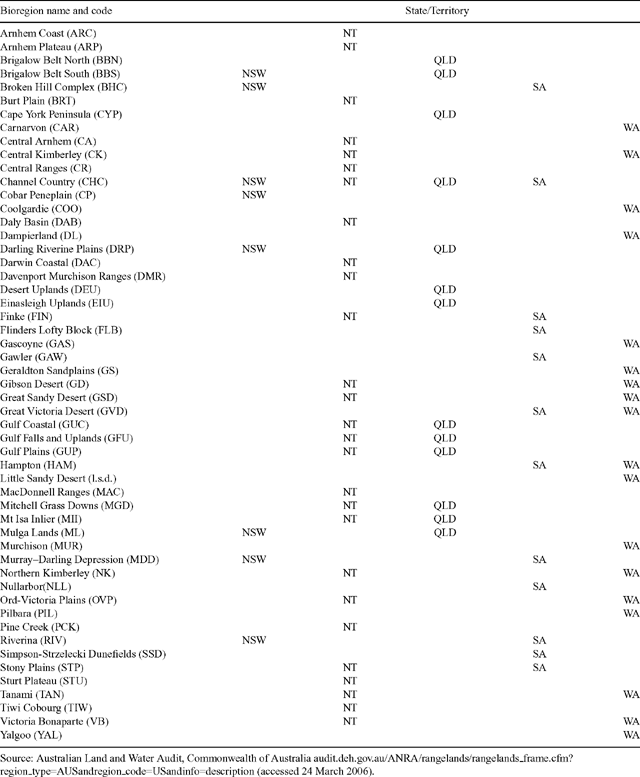
|















